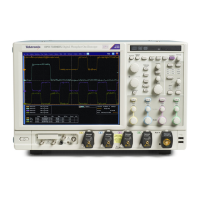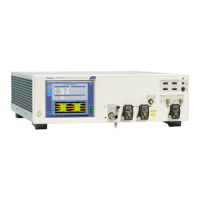



Do you have a question about the Tektronix DPO7000 Series and is the answer not in the manual?
Safety precautions to prevent fire and personal injury during operation.
Highlights the main capabilities and specifications of the instrument series.
Specifies environmental and physical requirements for instrument operation.
Provides essential techniques to prevent electrostatic discharge damage to the instrument.
Step-by-step guide for powering on the instrument, including power supply requirements.
Instructions for safely powering down the oscilloscope and removing power.
Identifies and describes the controls and connectors on the instrument's front panel.
Details the connectors and ports located on the sides and rear of the instrument.
Details the functions of controls on the panel for specific instrument series.
Explains the control functions specific to the MSO5000 and DPO5000 instrument models.
Procedure to run and verify internal diagnostics for instrument functionality.
Steps to perform signal path compensation for accurate measurements.
How to connect and set up analog signal inputs for waveform acquisition.
Automatically configures instrument settings for optimal waveform display.
Covers probe compensation and fundamental acquisition processes.
Step-by-step guide to select and configure different waveform acquisition modes.
Procedures for initiating, stopping, and taking single acquisitions.
Accelerates acquisition to capture transient events and display phenomena intensity.
Leverages DSP for accurate rise time, extended bandwidth, and flat passband.
Connects logic probes and sets up digital channels for signal acquisition.
Configures serial and parallel buses for analysis, including type and display.
Explains trigger events, modes, and holdoff for precise signal capture.
Modifies trigger parameters and selects advanced trigger types via setup window.
Details various trigger types like Edge, Glitch, Width, Serial, and Bus.
Combines A and B triggers to capture complex signals based on sequential events.
Manages long record length waveforms with Pan/Zoom, play/pause, and search controls.
Marks and searches for specific events or regions within acquired waveforms.
Selects and configures automatic measurements for channels, math, or reference waveforms.
Performs spectral analysis on waveforms using predefined or advanced math expressions.
Compares signals to predefined templates or masks for pass/fail testing.
Compares active signals with template waveforms for pass/fail testing.
Guides users on creating custom control windows with frequently used instrument functions.
Demonstrates using FastAcq and triggering to find and capture infrequent signal anomalies.
Details electrical, mechanical, performance, and environmental specifications for probes.
| Brand | Tektronix |
|---|---|
| Model | DPO7000 Series |
| Category | Test Equipment |
| Language | English |











